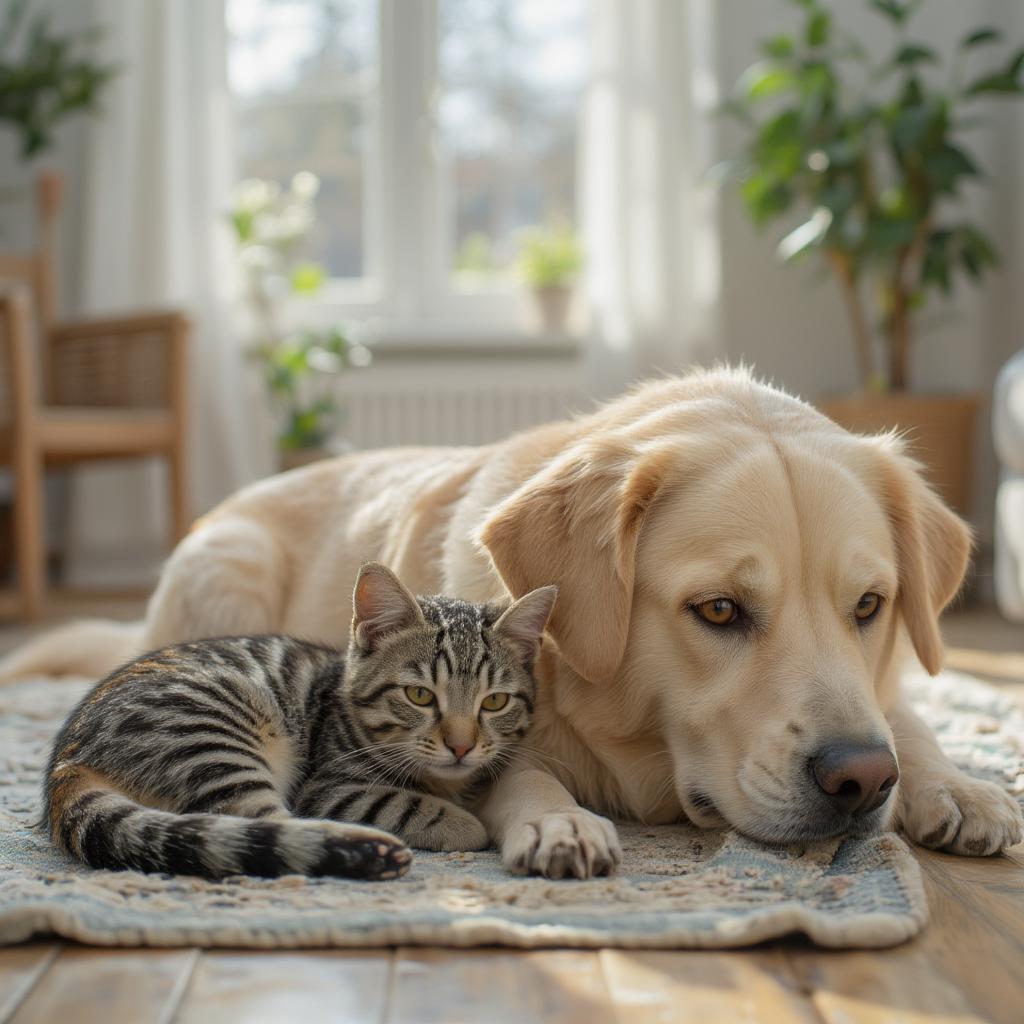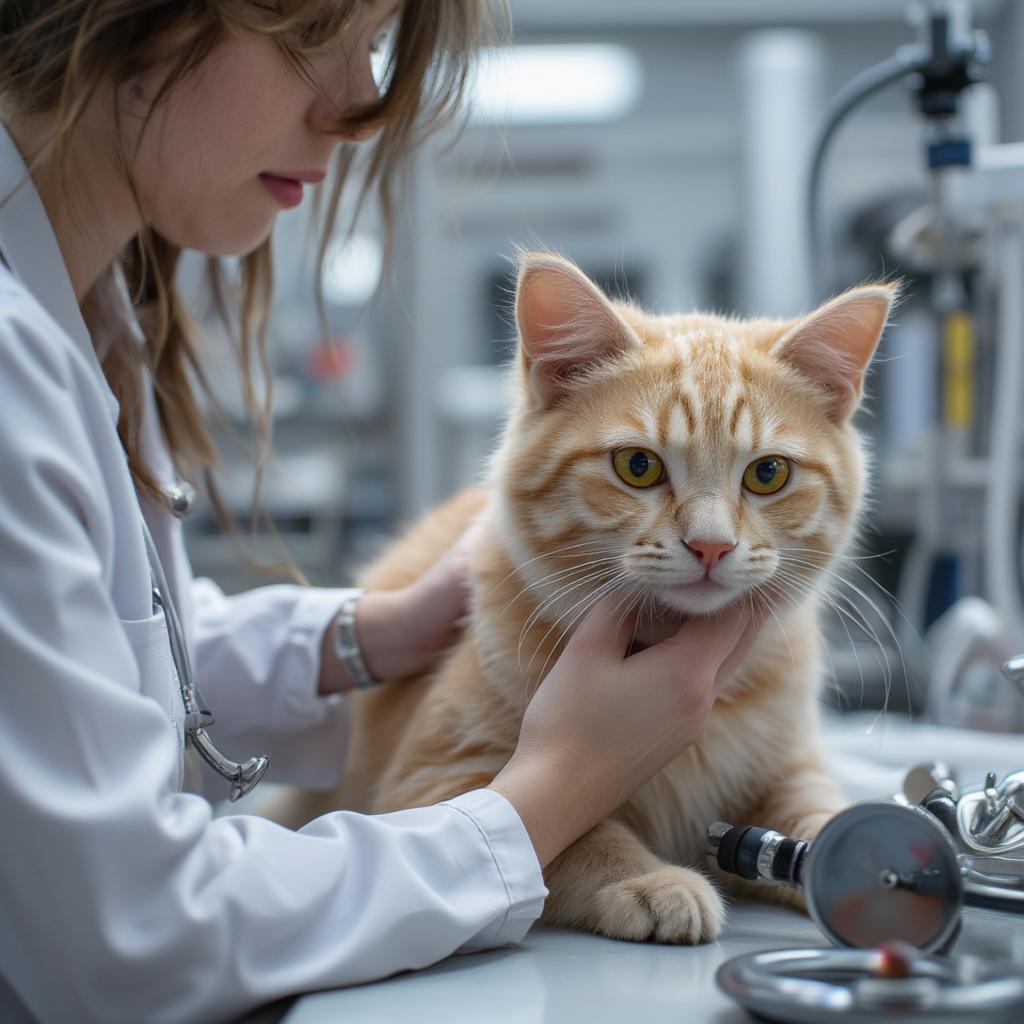Finding Rescue Dogs Good With Cats: A Guide for Harmony

Finding the right rescue dog that gets along well with cats is a top priority for many multi-pet households. It’s not just about avoiding conflicts; it’s about creating a loving and harmonious environment where everyone feels safe and happy. This guide dives into everything you need to know about selecting a rescue dog compatible with your feline friends.
Understanding the Dynamics: Why Some Dogs Love Cats and Others Don’t
Before we explore how to find Rescue Dogs Good With Cats, it’s crucial to understand that not all dogs are inherently “cat people.” Certain breeds have higher prey drives, making them more likely to chase or harass cats. Additionally, a dog’s individual temperament, upbringing, and past experiences play significant roles in how they interact with felines. Some dogs are naturally curious and friendly towards other animals, while others might be territorial or possess an intense hunting instinct.
- Prey Drive: This refers to a dog’s instinct to chase and potentially harm smaller animals, it’s deeply rooted and can be hard to overcome completely.
- Socialization: Dogs that are exposed to cats positively early in life are more likely to accept them as companions.
- Individual Temperament: A dog’s personality is a big factor. A laid-back, gentle dog is more likely to co-exist peacefully with a cat.
Assessing Your Home and Lifestyle: The First Step
Before bringing home a rescue dog, ask yourself these vital questions. Is your home suitable for both cats and dogs? Do you have the necessary space, resources, and time to care for both species? How do your cats behave around other animals? An honest assessment of your living situation helps prevent future issues and facilitates a smoother transition.
Key Breeds That Often Play Well With Cats
While breed is not a guarantee of a dog’s behavior, some are generally known for their laid-back and friendly nature, making them more likely to get along with cats. Remember, it’s always best to meet the individual dog and assess its personality rather than relying solely on breed. Here are some breeds often considered good for households with cats:
- Golden Retrievers: Known for their gentle temperament and eagerness to please, Golden Retrievers are often a safe bet for families with cats. They tend to be friendly and are usually good with children and other pets.
- Labrador Retrievers: Similar to Goldens, Labs are generally very tolerant and easy-going, making them compatible with cats. They are also intelligent and trainable.
- Bichon Frise: These small, cheerful dogs are usually very adaptable and happy to get along with anyone, including cats. Their low-prey drive makes them a good choice.
- Cavalier King Charles Spaniels: These gentle dogs are affectionate and playful, often forming strong bonds with their human and animal family members.
- Greyhounds: Despite being known for racing, many retired greyhounds have a lower energy level and can be surprisingly gentle with cats.
- Important Note: Even within these breeds, individual dogs can vary greatly in temperament, so always evaluate a specific dog rather than making assumptions based on breed alone.
“A dog’s breed is merely a piece of the puzzle,” says Dr. Emily Carter, a renowned animal behaviorist. “It is critical to focus on the individual animal’s disposition and past experiences when considering their compatibility with cats.”
Signs of a Rescue Dog That May NOT Be Good With Cats
It’s important to be aware of the signs that might indicate a dog is not a good fit for a home with cats. Look out for these behaviors during your introductions and interactions:
- High prey drive: This can manifest in a dog that intently stares at small animals, becomes very excited when they move, or has an aggressive way of chasing.
- Excessive barking or growling at cats: If a dog shows immediate aggression towards cats, it’s a red flag.
- History of chasing or hurting smaller animals: Ask the rescue organization about the dog’s history and how they’ve interacted with other animals previously.
How to Conduct a Safe Introduction Between Dogs and Cats
Introducing a new rescue dog to your cat or cats is a delicate process that requires patience and caution. Don’t rush things; start slowly and take the necessary steps to ensure safety and minimize stress.
-
Scent Exchange: Allow your dog and cat to smell each other through a closed door or using a blanket or a towel. This helps them become familiar with each other’s scents without a direct confrontation.
-
Controlled Visual Contact: Begin with very short supervised visits with the dog on a leash, and allow the cat to have a clear escape route. The goal is to monitor their reactions closely. If either animal appears stressed, end the interaction and try again later.
-
Gradual Unsupervised Access: Once both animals seem comfortable, slowly allow them to share common spaces while still supervising their interactions. It’s important to observe body language and intervene if things become tense.
- Body Language: Be on the lookout for signs of anxiety or aggression, such as flattened ears, tense posture, or excessive growling, which indicates that it is not a good time to let them interact directly.
What Questions Should You Ask the Rescue Organization?
When considering adopting a rescue dog, gather as much information as possible about their history and temperament. Here are some key questions to ask the rescue organization:
- Has the dog been around cats before?
- How did the dog behave around cats in its previous environment?
- Does the dog have any known behavioral issues related to other animals?
- What is the dog’s temperament like? Is it generally laid-back or high-energy?
- Does the dog have a strong prey drive?
- What specific steps did you use to assess the dog’s cat-compatibility?
“Open and honest communication with the rescue organization is critical,” states veterinarian Dr. Michael Thompson. “Their insights into the dog’s behavior and history can provide invaluable information about whether the dog is likely to be a good fit for your home.”
Training and Management Strategies to Ensure Harmony
Even with the best introductions, you need ongoing management and training to help ensure a peaceful coexistence between your dog and cat.
- Basic Obedience: A well-trained dog is easier to manage in a multi-pet household. Teaching commands like “leave it” can be helpful in preventing your dog from chasing or bothering your cat.
- Safe Spaces: Make sure both your dog and cat have their own safe spaces. A cat should have places it can escape to where a dog cannot follow.
- Supervision: Continue to supervise their interactions, especially in the beginning. It will take some time for both animals to get comfortable and establish a routine.
- Positive Reinforcement: Reward your dog for calm behavior around the cat. Positive reinforcement is far more effective than punishment in creating a positive association.
What to Do If Things Aren’t Going Well
Despite your best efforts, sometimes things don’t work out as planned. If your dog and cat are not getting along, consult with a professional dog trainer or behaviorist. They can help you assess the situation and develop a tailored strategy.
- Don’t give up: If things aren’t going well right away it may take time, and even professional intervention to create a positive environment for all of your pets.

Special Considerations for Senior Rescue Dogs
Senior dogs can make wonderful companions for cats. Their energy levels are often lower, and they tend to be more mellow. However, remember to take into account their potential health issues, and be sure that there are appropriate accommodations for their physical needs.
- Lower Energy: Senior dogs tend to be less excitable, which is often better for cats that prefer a quieter environment.
- Patient Introduction: A slow and patient introduction is still key for the success of a multi-pet household and can reduce stress for a senior dog.
Building A Home Full of Love
Finding the perfect rescue dog that gets along with cats isn’t always easy but it is very possible. By taking the time to understand the dynamics of dog-cat relationships, you can create a safe and nurturing environment for all your animals. Remember, it takes patience and understanding, but the reward of seeing a peaceful and loving multi-pet household is well worth the effort.
“Patience and consistent positive reinforcement are the foundation for a harmonious multi-species household,” notes Sarah Miller, a prominent pet adoption counselor. “The key is to focus on building trust and understanding between all your pets.”
Conclusion
Finding rescue dogs good with cats is achievable with the right approach. A thorough understanding of dog behavior, combined with careful introductions and consistent management, can pave the way for a harmonious and loving home. By considering all aspects of your lifestyle and the dog’s temperament, you can create a space where both dogs and cats thrive. Remember, the journey requires commitment, patience, and lots of love, but it’s a truly rewarding experience to see your furry family become best friends. By choosing adoption, you are providing a loving home to a dog in need and opening your heart and home to a lifetime of joy and companionship.
FAQs
Q: What are some specific signs to look for that indicate a rescue dog is not good with cats?
A: A dog that exhibits an intense stare, high excitement, or an aggressive way of chasing after small animals likely has a strong prey drive and may not be compatible with cats. Excessive barking or growling at the sight of a cat are also red flags.
Q: How important is breed when choosing a rescue dog that gets along with cats?
A: While certain breeds are known for being gentle and good with cats, breed is not the only factor. Individual temperament, socialization, and previous experiences are equally important. It is critical to focus on an individual dog and its unique characteristics.
Q: What’s the best way to introduce a new rescue dog to my resident cat(s)?
A: Start with scent exchange, followed by controlled visual contact with the dog on a leash, then gradually introduce them to sharing common spaces, always under supervision, and take plenty of time to ensure the animals are relaxed and safe.
Q: How can I ensure that my cat has a safe space from my new dog?
A: Make sure that your cat has access to safe spaces where the dog cannot follow or reach it. This could be high shelves, a dedicated room, or cat trees.
Q: What should I do if my new rescue dog continues to chase my cat?
A: If chasing persists, consult with a professional dog trainer or animal behaviorist. They can help assess the situation and implement strategies to manage the behavior, always ensuring safety for both animals.
Q: Is it still possible to have a dog and a cat get along if the dog has a prey drive?
A: It’s possible, but it requires extensive and consistent training, management, and, in some cases, professional intervention. It is essential to keep them separate at any time that they cannot be supervised to ensure no chasing occurs.
Q: How long does it typically take for a dog and cat to adjust to each other?
A: It can vary widely based on individual personalities and the animals’ past experiences. Some may adjust within a few weeks, while others might take several months, patience and understanding are essential for successful integration.




